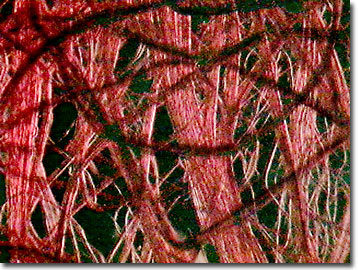Darkfield Image Gallery
Jute
Jute is a strong, coarse natural fiber used for making burlap, gunny, floor coverings, and ropes. Two annual plants in the linden family (Tiliaceae) from India, Cochorus capsularis (white) and C. olitorius (tossa) are the sources for jute fiber.

Jute plants prefer sandy soil and subtropical climates. The stalks, over 3 meters in height, are gathered by hand and softened in water. Then the fiber is stripped away from the bark by hand (retting) and woven into usable product. Nicknamed the golden fiber, jute fiber deteriorates rapidly and because of uneven diameters and comparatively low cellulose concentrations, jute is relatively weak. Its low cost and great abundance coupled with the ease of dyeing and spinning, makes jute the principal coarse fiber in commercial production and use. Jute fiber retains its shape, absorbs around ten times the noise level of a synthetic carpet, produces no toxic fumes as are associated with synthetic fibers, and can act as an excellent insulator. Unlike synthetic textiles, jute materials are static free, humidity regulating, and possibly anti-bacterial. Higher quality jute fiber is destined for yarns for fabrics while the lower grades are used for gunnysacks and baling twine. The capsularis fiber is white in color while the olitorious fiber is finer and stronger, but yellow-red or gray in color. Over-retting results in lusterless and weak fibers.
Although Cochorus are readily adaptable to loamy soils in hot and humid climates, production is largely limited to India and Pakistan, because of the demand for a large, cheap labor force. Cultivated in India since ancient times, jute plants have only been known in Western commerce since about 1830. The jute industry has suffered, starting with the partition of India and Pakistan in 1947, separating the mills from the crop fields, and further with the competition created by synthetic fibers and plastics. In the 1950s, new mills were built in East Pakistan, now known as Bangladesh, and jute is that country's leading cash crop. As the world's petroleum resources are depleted for energy consumption and in the chemical industry, perhaps resurgence in demand for jute, a renewable and fully recyclable natural resource, will follow in the future. Most recently, jute fibers were blended with acrylics, rayon, silk, polyester, cotton, and other types of fibers to develop new textiles for the marketplace. Research is being carried out to explore the manufacture of paper pulp from jute, and the use of jute geotextiles in road construction.
In West Africa, imported jute plants are not only used for fiber production, but are important as a vegetable because of their smooth-tasting greens. If allowed to go to seed, jute plants produce bright yellow flowers, which produce elongated pods filled with small, dark green seeds.
Contributing Authors
Cynthia D. Kelly, Thomas J. Fellers and Michael W. Davidson - National High Magnetic Field Laboratory, 1800 East Paul Dirac Dr., The Florida State University, Tallahassee, Florida, 32310.
BACK TO THE DARKFIELD IMAGE GALLERY
BACK TO THE DIGITAL IMAGE GALLERIES
Questions or comments? Send us an email.
© 1995-2025 by Michael W. Davidson and The Florida State University. All Rights Reserved. No images, graphics, software, scripts, or applets may be reproduced or used in any manner without permission from the copyright holders. Use of this website means you agree to all of the Legal Terms and Conditions set forth by the owners.
This website is maintained by our
Graphics & Web Programming Team
in collaboration with Optical Microscopy at the
National High Magnetic Field Laboratory.
Last Modification Friday, Nov 13, 2015 at 01:19 PM
Access Count Since September 17, 2002: 16575
Visit the website of our partner in introductory microscopy education:
|
|
